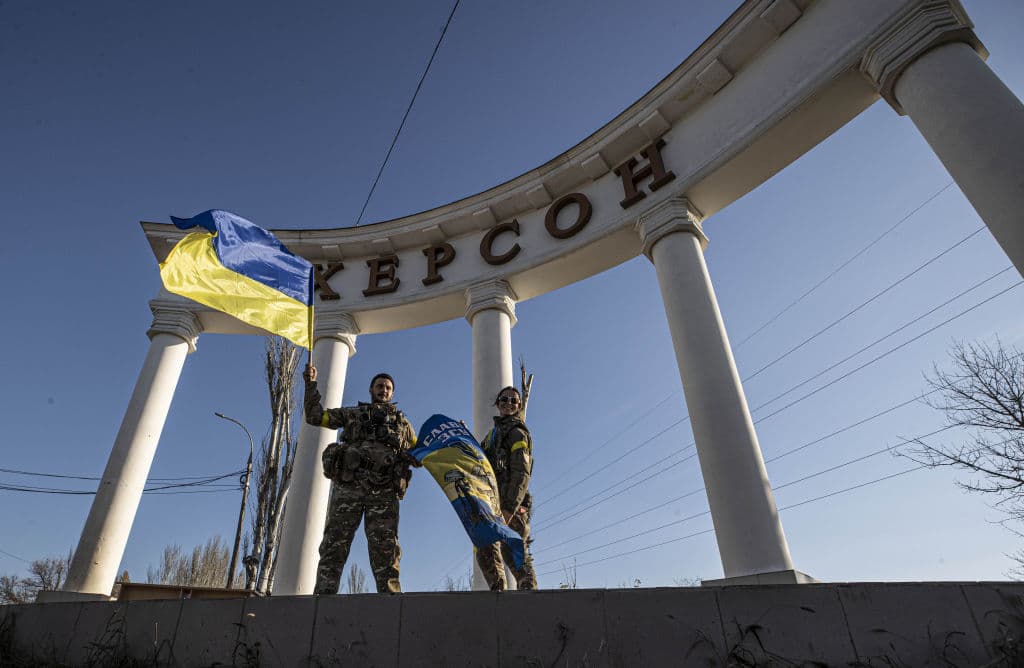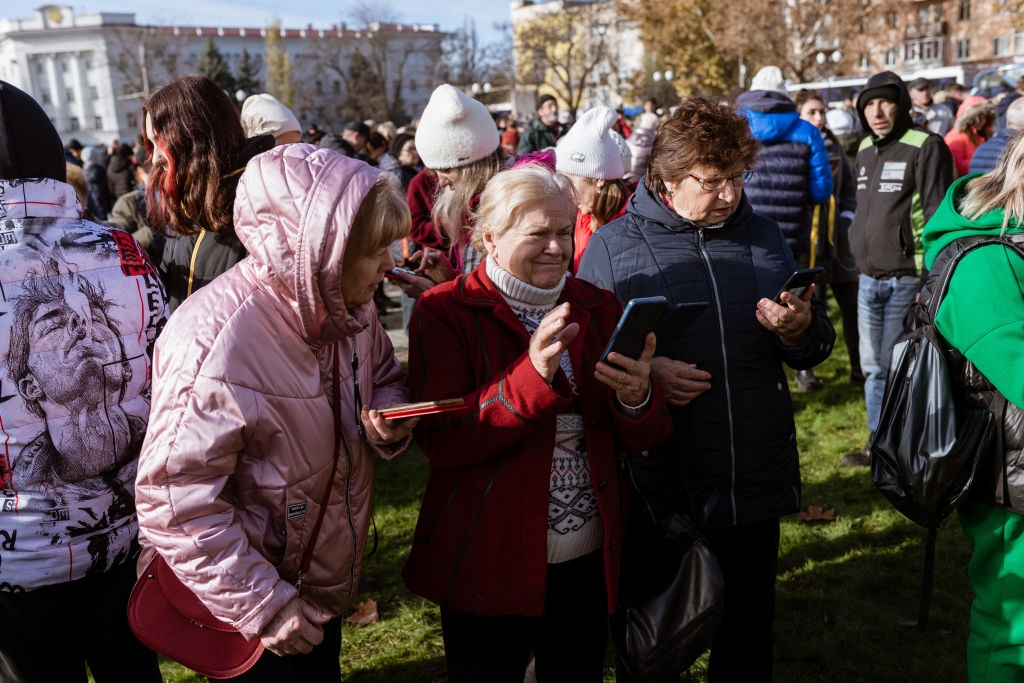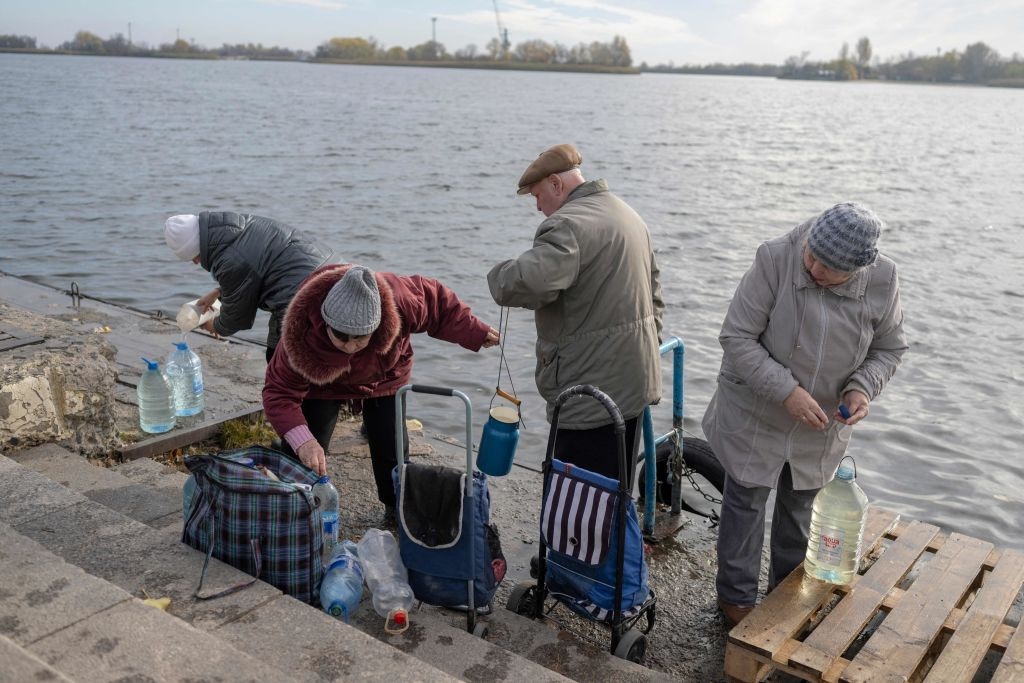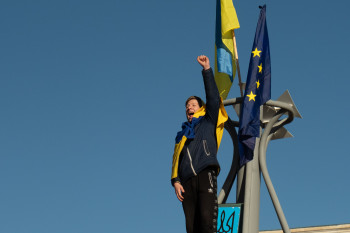Kherson chronicle: From quick fall to liberation

Ukraine's recapture of the southern city of Kherson came as a happy surprise for exiled local journalist Kseniya Keleberda.
"When Ukrainian forces first entered Kherson, we cried and smiled at the same time," she told the Kyiv Independent.
Survivors of the eight-month-long Russian occupation immediately began celebrating at the central Freedom Square on Nov. 11. Keleberda hasn't been able to get in touch with her loved ones yet due to unstable connection in the newly liberated city.
Worrying over her husband, who decided to stay behind, Keleberda spent the last couple of months regularly texting him to be reassured from afar. She is now in Bucharest after fleeing Kherson in April.
Keleberda said that "the scariest" time of her life was in August when she heard nothing from her husband and son for nearly a week. It turned out that they were detained and beaten by Russian troops for a day after several days of house arrest, she said, calling it "an amazing coincidence" that both of them were released with minimal injuries.
But it's not been the case for some of her friends. One of Keleberda's long-time companions was fatally shot while evacuating his family, and another is still missing after his blood-coated clothing was found at his country house, she was told.
A few days after Ukrainian forces retook Kherson, law enforcement had begun documenting war crimes to hold Russia accountable for them. President Volodymyr Zelensky said that over 400 war crimes committed by Russian troops were already discovered in the wider region.
Kherson, once home to some 280,000 people, was the only regional capital that Moscow was able to capture since the launch of the full-scale war in February.
In yet another humiliating defeat, the Russians were forced to completely withdraw from the city amid Kyiv's advancing months-long counteroffensive.
Thousands of Kherson residents are anxiously waiting to be allowed to return. Ukrainian authorities are slow on allowing residents to return, saying that the area is still heavily mined.
"I want to walk around the city I love so much and look at all that is left there," Keleberda said.

Battle for Kherson
Kherson became the first major city to fall to invading Russian troops in early March.
Ukraine's defenses in the south collapsed unexpectedly early after a large Russian army headed toward Kherson from Crimea, occupied by Moscow in 2014.
Kherson was surrounded by late February, and Russians had already installed checkpoints at entries on March 1. Explosions were heard across the city, and residents hid in basements.
Encountering minimal resistance, the Russian army is assumed to have captured the southern regional capital the following day.
Russia's war goals in the south were clear – cut off Ukraine's access to the Black Sea (the key trade route) to destroy its agriculture-centric economy and get hold of a canal to resolve its water problems in occupied Crimea. The first goal quickly fell apart, but the latter one was partially fulfilled.
Particularly heavy fighting was reported to have taken place on March 1. A graphic video that surfaced online shows bodies of Ukrainian soldiers with missing limbs or heads left behind in a park.
A senior combat medic (then a soldier) described the day as the most tragic day in the battle for Kherson in an Ukrainska Pravda article, saying that four dozen territorial defense soldiers were using machine guns and Molotov cocktails to fight off Russians who had armored vehicles.
Till then, the ex-soldier said in the interview that his group was among the 500-600 military personnel hiding at a boarding school in central Kherson for reasons he still doesn't understand.
Weeks of defiance
During the first weeks of Russian occupation, massive peaceful pro-Ukrainian rallies in Kherson took place on a regular basis.
Kherson residents would gather every day at around 12 p.m. at the central Freedom Square to resist Russian occupation, and journalist Keleberda said, who took part in those rallies.
They felt close to each other even though they were strangers because they were going through a shared struggle, she added.
Local residents were forced to follow a curfew installed by Russian troops, which lasted from 8 p.m. to 6 a.m. every day.
On March 13, residents held a few hundred-meter-long Ukrainian flag during the biggest rally yet as the city marked a liberation day from Nazi forces (in 1944). More than 5,000 people are said to have gathered at Freedom Square.
Then the first civilian casualties were recorded at one of the rallies closer to the end of March, and they kept rising. Many stopped attending them soon due to fears that they could be detained or, worse – killed.
Russians were using tear gas, stun grenades, and gunfire to disperse rallies in an attempt to tighten control of the occupied city. "Organizers" of the rallies were aggressively searched.

Kremlin's tightening control
Unlike in other occupied cities, the Ukrainian-appointed city council in Kherson continued to work for a few months until Russian troops stormed the administrative building on April 25.
By then, 40 percent of residents had fled Kherson, according to Mayor Ihor Kolykhaiev's estimate. While deprived of his mayoral work, Kolykhaiev stayed behind until he was kidnapped in June. He remains nowhere to be found.
The mayor's son said that Kolykhaiev was in Russian captivity for five months. State authorities are investigating the kidnapping.
People continued to flee Kherson. Others spent most of their time indoors, fearing repercussions for their pro-Ukrainian stance.
Counteroffensive threats
As early as June, Ukrainian officials began to call on residents living in the occupied part of Kherson Oblast to flee their homes ahead of Kyiv's potential counteroffensive.
"We will come to Kherson. And ordinary Kherson residents will meet our army on the streets of the city," Zelensky vowed in his evening address on June 13.
Ukraine gradually began targeting bridges to hamper Russian logistics in order to make it as difficult as possible for the occupying forces to pull in more troops and equipment for Kherson's defense.
The long-anticipated announcement of the beginning of the southern counteroffensive came on Aug. 29.
By the end of the next month, Moscow said it annexed Kherson, along with the rest of Kherson Oblast and three other partially occupied Ukrainian regions, in a likely move to establish firmer control over territory it declares "its own."
That move didn't help Russia maintain control over the city.

Victorious Ukraine
The louder explosions got at night, the more hope Kherson residents began to have for a potential liberation of their city.
Over the past month, Ukrainian strikes on Russian military sites in and around occupied Kherson significantly increased, Keleberda was told by her husband.
By then, the Russians in the city were visibly in chaos because they were in the middle of their disorganized campaign to flee across the Dnipro River, which cut Kherson from Russia's main logistical hubs.
Soon after, Russian Defense Minister Sergei Shoigu ordered an unexpectedly early withdrawal from Kherson, justifying the humiliating retreat as necessary to increase military presence elsewhere.
Keleberda said she couldn't sleep on the days leading up to the long-awaited liberation day because of heightened excitement.
"Our city will be even better than it was before. We will rebuild it," Keleberda said.
__________________________________
Note from the author:
Hi, this is Asami Terajima. Thank you for reading my story till the end. The Kyiv Independent team has been selflessly covering Russia's brutal war against Ukraine since day one, doing our best to keep the world informed about the latest developments at home. Please consider supporting the young and driven newsroom by becoming our patron.










